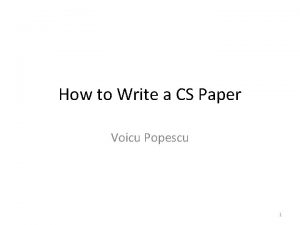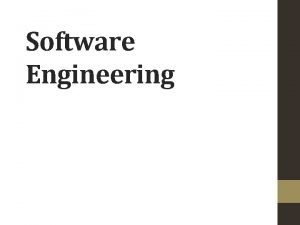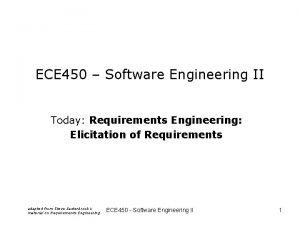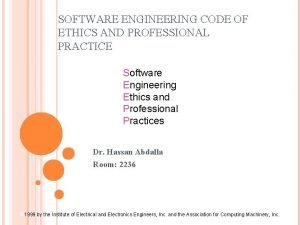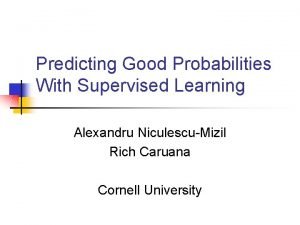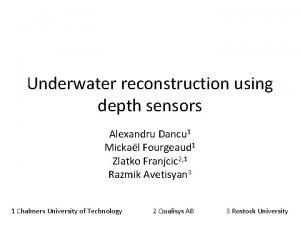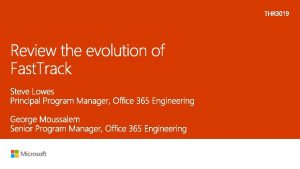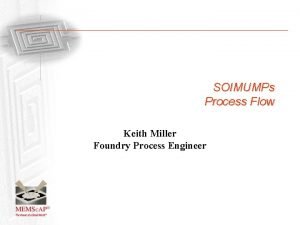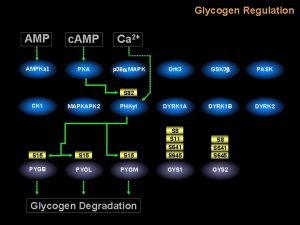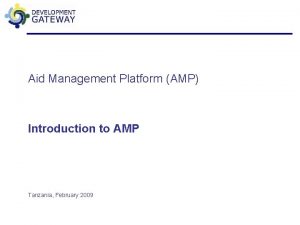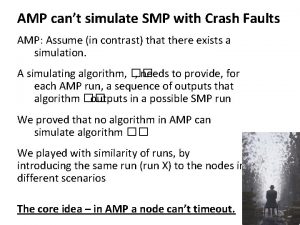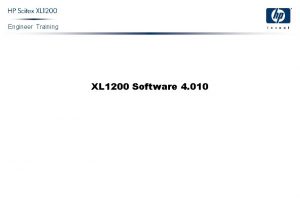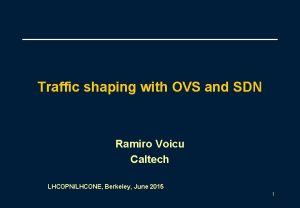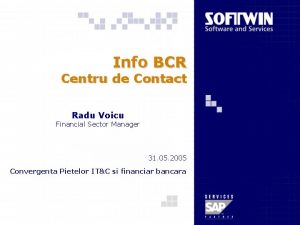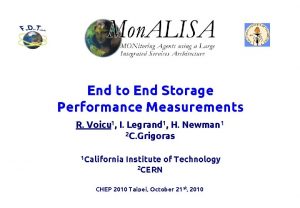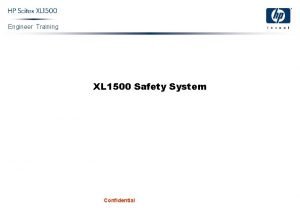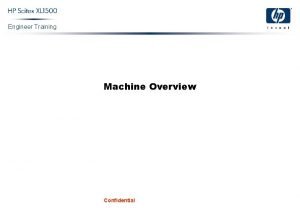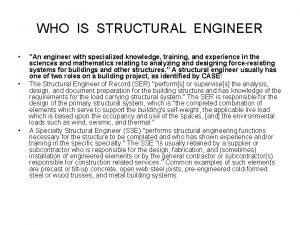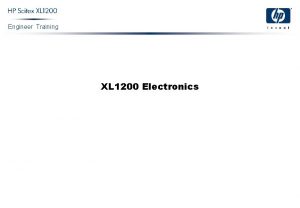C AMP Alexandru Voicu Ph D Software Engineer











































- Slides: 43

C++ AMP Alexandru Voicu, Ph. D. Software Engineer Visual C++ Libraries

Inspiration THIS !THIS

Goals 1. Describe the fundamental abstractions lying at the core of the C++ AMP programming model; 2. Introduce the core elements of the C++ AMP programming model: a) The array_view Abstract Data Type (ADT); b) The accelerator ADT; c) The simple, implicitly partitioned execution model; d) The tiled, explicitly partitioned execution model; 3. Discuss inter-operation with graphics APIs (e. g. Direct. X).

C++ AMP FUNDAMENTALS

C++ AMP at a glance? accelerator_view index<. . . > tiled_index<. . . > extent<. . . > tiled_extent<. . . > array_view<. . . > parallel_for_each<. . . >(…) restrict(. . . ) tile_static barrier

C++ AMP at a glance It is JUST C++, not C or pseudo-C, not intrinsics, not a heavy handed extension: a) C++ code is written inline; b) No mysterious invocations of unutterable functions; c) Seamless data-movement (when using array_views); d) Unique parallel_for_each entry-point (library function, not “magical”).

The abstract machine model We program processors: 1. With a variable number of cores; 2. Capable of executing SIMD threads; 3. Which follow the Von Neumann paradigm. Everything else is business as usual: 1. The interaction with memory matters for performance– locality, regularity etc. 2. “It’s all about algorithms and data-structures!” Alexander Stepanov This is necessary and sufficient understanding for efficiently programming {C, G, A, *}PUs!

C++ AMP – first steps Answering three key questions: 1. “What to do? ” -> the parallel_for_each function; 2. “Where to do it? ” -> the accelerator ADT; 3. “With what data? ” -> the array_view ADT.

What to do (I) The parallel_for_each function logically: 1. Describes a computation: a) To be performed by an accelerator; b) Across some N-dimensional execution domain; c) Which can be performed in SIMD fashion; d) That meets a set of constraints (restrict); 2. Juxtaposes the “where” (accelerator) and the “with what” (data, preferably wrapped in an array_view).

What to do (II) 12/03/2021 10

What to do (III)

12/03/2021

Where (I) The accelerator ADT logically: 1. Acts as an abstraction for a computation capable resource, which can be a CPU or a GPU (today), might be an FPGA, DSP or some other physical accelerator (tomorrow); 2. Alongside array_view, makes heterogeneous, locality aware computing possible: a) HETEROGENEOUS -> the abstract model maps to different types of processors; b) LOCALITY AWARE -> accelerator has unique identity and location in a system’s topology, and can “own” resources e. g. a set of datum.

Where (II) The accelerator ADT practically: 1. Exposes a mechanism for enumerating all computation capable resources available in a system (accelerator: : get_all()); 2. Enables the introspection of hardware properties through its member functions; 3. Creates accelerator_views that are used to associate computation or data with a particular accelerator. The runtime provides reasonable defaults, so you can frequently blissfully ignore the above!

12/03/2021

What data (I) The array_view ADT logically: 1. Represents an N-dimensional space which: a) Resides either on the host’s or an accelerator’s memory space; b) Can be accessed and “understood” by accelerators. 2. Alongside accelerator, makes SEAMLESS heterogeneous, locality-aware, computing possible and ACCESSIBLE: a) SEAMLESS – the programmer does not have to worry about shuffling data; b) ACCESSIBLE – the programmer does not have to get into low-level data movement and locality details for writing efficient programs.

What data (II) The array_view ADT practically: 1. Wraps a set of datum (e. g. an int, a std: : vector, built-in array etc. ): a) Makes it trivial to view flat data as an N-dimensional space – a matrix is a matrix and behaves like one, not std: : vector<T>> or T[m][n]; b) Allows the programmer to focus on the algorithm – synchronization between host - accelerator and accelerator – accelerator is implicit; c) Future-proofs code by rapport with the extension towards other accelerators – let the implementation do the work of getting data into the cloud! Unless absolutely necessary, try to write against the array_view abstraction!

12/03/2021

Clarification – restrict(amp) (I) • Compile-time safety net – check if your elemental function can be compiled for accelerators; • The restrictions are there mostly due to historical reasons and a slant towards “nanny”-ism by rapport with the developer; • For a comprehensive list see section 2 in the open specification: http: //download. microsoft. com/download/2/2/9/22972859 -15 C 2 -4 D 96 -97 AE 93344241 D 56 C/Cpp. AMPOpen. Specification. V 12. pdf

Clarification – restrict(amp) (II) 1. In hindsight, restrict(amp), as implemented, was probably an uninspired design choice: a) composing functions becomes tricky, there is a ripple effect; b) reusing perfectly valid existing code is non-trivial (e. g. std: : min); c) adds cognitive overhead and can be confusing – C++ does not really need more keywords, especially special ones! 2. AMD and Multicoreware did a great job with the C++ AMP programming model: a) implemented it for Linux and OS X (on top of Clang / LLVM); b) “eviscerated” most of the restrictions (and ultimately restrict itself); c) https: //bitbucket. org/multicoreware/cppamp-driver-ng/wiki/Home

Code!

Example I – Vector Valued Functions 12/03/2021 22

Vector Valued Function in C++ template<typename T, typename Op> void vector_transform(vector<T>& X, Op F) { transform(begin(X), end(X), begin(X), F); }

Vector Valued Function in C++ AMP template<typename T, typename Op> void vector_transform(vector<T>& X, Op F) { array_view<T> X_acc(X); const auto lanes = X. extent; } parallel_for_each(lanes, [=](index<1> lane) restrict(amp) { X_acc[lane] = F(X_acc[lane]); });

Code example II – rotate 12/03/2021 25

rotate in C++ (NOT std: : rotate) template<typename I> I rotate(I first, I new_first, I last) { if (first == new_first) return last; if (new_first == last) return first; reverse(first, new_first); reverse(new_first, last); reverse(first, last); } return first + distance(new_first, last); 12/03/2021 26

rotate in C++ AMP template<typename I> I rotate(I first, I new_first, I last) { if (first == new_first) return last; if (new_first == last) return first; reverse(first, new_first); reverse(new_first, last); reverse(first, last); } return first + distance(new_first, last); 12/03/2021 27

rotate reverse in C++ AMP template<typename I> void reverse(I first, I last) { if (distance(first, last) <= 1 u) return; const array_view<Value_type<I>> range(distance(first, last), &*first); const auto lanes = range. extent / 2 u; parallel_for_each(lanes, [=](index<1> lane) restrict(amp) { swap(range[lane], range[range. extent. size() - lane[0] - 1 u]); }); } 12/03/2021 28

rotate reverse swap in C++ AMP template<typename T> inline void swap(T& x, T& y) restrict(amp) { T tmp(y); y = x; x = tmp; } 12/03/2021 29

Why (A) Vector Valued Functions (dataset = 227 floats) Intel Core i 7 -4600 U (CPU) Intel Core i 7 -4600 U (GPU - compute only) AMD A 10 -7850 k (CPU) AMD A 10 -7850 K (GPU - compute only) 1518 1600 1400 1252 milliseconds 1200 946 1000 961 900 800 600 400 266 383 350 85 540 458 535 390 276 105 966 909 85 104 84 100 85 94 0 Addition 12/03/2021 2 nd degree polynomial Logit function Logistic function 30

What have we learned (A) Data movement is frequently the elephant in the room: a) Be aware of your workload’s arithmetic intensity, if you want to execute on a disjoint accelerator – make sure that you’re doing enough work per byte to amortise the cost of hauling it across into accelerator memory b) Be aware of your data’s residence and locality – try to cut out movement, process the data where it resides (array_views take away this concern) c) GPUs aren’t orders of magnitude faster (it is a nonsensical claim), however the presence of dedicated hardware or graphics specific features can yield superlinear speedups – e. g. transcendental functions or bilinear filtering are much faster 12/03/2021 31

Why (B) rotate (dataset = 227 floats) Intel Core i 7 -4600 U (CPU) Intel Core i 7 -4600 U (GPU - compute only) AMD A 10 -7850 K (CPU) AMD A 10 -7850 K (GPU - compute only) 3500 2924 3000 2753 milliseconds 2500 2000 1559 1500 1000 562 249 430 124 1530 1507 173 339 479 126 187 418 1428 566 565 125 175 246 425 124 174 0 r = begin(X) + 1 12/03/2021 r = X. size() / 8 r = X. size() * 7 / 8 r = end(X) - 1 32

What have we learned (B) What we had discovered at (A) with a bonus: a) Revisiting algorithms in order to find solutions for accelerators can lead to interesting insights – Gries-Mills (this implementation of the standard library used the “Dolphin” for std: : rotate), appears to have some glass jaws – theories? b) Accelerators (in this case GPUs) can be useful in general, not only for arithmetic tasks – as long as we carefully analyse the workload and the greater context. 12/03/2021 33

So how many pictures are 109 bytes of data worth?

Visualisation is important – interoperability should be your friend 1. Having a large amount of data is merely the start of an analysis, not its end; 2. Visualising a dataset is almost a sine qua non requirement in various fields: a) In spite of this, interoperability between GPU compute APIs (e. g. CUDA or Open. CL) and rendering APIs (e. g. Direct. X, Open. GL) is a rather awkward / unwieldy proposition; b) There are historical and practical reasons for this (e. g. different API infrastructure, undefined / implementation specific behaviour etc. ); 3. This is one area where the tight coupling between C++ AMP and Direct. X is beneficial (this does not apply to the AMD/MCW implementation).

Visualisation is important – with C++ AMP, interoperability is your friend 1. The shared infrastructure makes interop between C++ AMP and Direct. X trivial: a) Two functions to retrieve the accelerator (create_accelerator_view) and the data being operated on (make_array) from Direct 3 D 11+; b) Two functions to pass the accelerator (get_device) and the data being operated on (get_buffer) to Direct 3 D 11+; 2. Beyond these mechanisms, if you know Direct 3 D, it's business as usual: a) No performance loss versus using Direct. Compute (but productivity is gained); b) No reliance on IHV specific solutions (beyond the need for compliant Direct 3 D 11+ drivers).

Preliminary conclusions 1. 2. 3. 4. 5. Writing heterogeneously accelerated parallel programs is not hard! Still about algorithms and data structures (come tomorrow for more on this topic)! Rely on the implementation for tedious work (accelerator choice, data shuffling)! Act now, start programming these new, parallel, heterogeneous machines! C++ AMP is available on Linux, Windows and OS X – why not give it a spin?

if (time) read({A, B}); EXCELLENT BOOK ON PROGRAMMING

if (more_time) read({B, C}); GOOD BOOK ON PARALLEL PROGRAMMING WITH C++ AMP

https: //bitbucket. org/multicoreware/cppamp-driver-ng/overview Microsoft C++ AMP Landing Page Useful links (I) https: //msdn. microsoft. com/en- us/library/hh 265137(v=vs. 140). aspx

Algorithms library: http: //ampalgorithms. codeplex. com/ p. RNG library: http: //amprng. codeplex. com/ FFT library: http: //ampfft. codeplex. com/ BLAS library: http: //ampblas. codeplex. com/ LAPACK library: http: //amplapack. codeplex. com/ Useful links (II)


“Lasciate ogni speranza, voi ch’entrate!”
 Madeleine voicu wikipedia
Madeleine voicu wikipedia Voicu popescu
Voicu popescu Real op amp vs ideal
Real op amp vs ideal Software engineering
Software engineering Software engineer vocabulary
Software engineer vocabulary Software engineer technical questions
Software engineer technical questions Software engineer technical questions
Software engineer technical questions What is software engineering code of ethics
What is software engineering code of ethics Spacex salary aerospace engineer
Spacex salary aerospace engineer Tema nuvelei alexandru lapusneanul
Tema nuvelei alexandru lapusneanul Scoala gimnaziala alexandru ivasiuc baia mare
Scoala gimnaziala alexandru ivasiuc baia mare Octavian paler alexandru paler
Octavian paler alexandru paler Fabule de alexandru donici lupul si cucul
Fabule de alexandru donici lupul si cucul Catalin condurache wiki
Catalin condurache wiki Famous romanian scientists
Famous romanian scientists Colegiul national alexandru ioan cuza
Colegiul national alexandru ioan cuza Scoala alexandru cel bun bacau
Scoala alexandru cel bun bacau Scoala 21 baia mare
Scoala 21 baia mare Colegiul national alexandru ioan cuza corabia
Colegiul national alexandru ioan cuza corabia Facultatea de psihologie iasi
Facultatea de psihologie iasi Predicting good probabilities with supervised learning
Predicting good probabilities with supervised learning Colegiul ecologic alexandru ionescu pitesti
Colegiul ecologic alexandru ionescu pitesti Scoala alexandru ivasiuc baia mare
Scoala alexandru ivasiuc baia mare Master academia de politie
Master academia de politie Ion george nicholas alexander lambrino
Ion george nicholas alexander lambrino Alexandru dancu
Alexandru dancu Alexandru cotescu
Alexandru cotescu Alexandru radoi
Alexandru radoi Stiloradial
Stiloradial Alexandru malaescu
Alexandru malaescu Bacrea
Bacrea Muzeul conacul bellu
Muzeul conacul bellu Alexandru ivasiuc
Alexandru ivasiuc Syderoblast
Syderoblast Oromaxilofacial
Oromaxilofacial Microsoft fasttrack engineer
Microsoft fasttrack engineer The certified quality engineer handbook
The certified quality engineer handbook Board of professional engineers texas
Board of professional engineers texas Soimumps
Soimumps Palo alto networks certified network security engineer
Palo alto networks certified network security engineer Lego therapy builder engineer supplier
Lego therapy builder engineer supplier Petroleum engineering pros and cons
Petroleum engineering pros and cons I prefer to choose ___ blue t-shirt rather than ___ red one
I prefer to choose ___ blue t-shirt rather than ___ red one Ceng 考牌
Ceng 考牌

